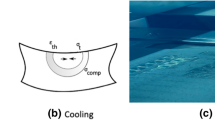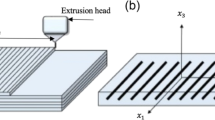Abstract
The sheet forming using flexible-die has been presented the great development potential, which uses the liquid, polyurethane rubber, rubber bladder, viscous medium, or magnetorheological fluid as the force transmission medium and shows some advantages. In this paper, the new method on the sheet flexible-die forming using the magnetorheological elastomer (MRE) is proposed. The MRE consists of magnetically polarizable particles locked into an elastomer matrix and has the magnetorheological effect under the action of a magnetic field. The mechanical property like the shear modulus of MRE can up to 160% in microseconds when the magnetic field is applied. Therefore, the performance behavior of MRE is controllable and adjusted, which can adapt the force requirements at different positions during the sheet metal forming process. Finite element analysis of Al1060 sheet bulge using MRE with different shear modulus was carried out. Results show that the right side of the FLD is obtained by using elliptical dies with different length–width ratios. On the basis of that a new method is proposed to obtain forming limit diagrams of sheet metal using the magnetorheological elastomer forming process at variable magnetic fields, bulging tests of the Al1060 sheet under different magnetic fields were implemented. FLD at different elliptical dies under the action of MRE is determined. An increase in forming limits of Al1060 with the increase in the magnetic field is observed.


















Similar content being viewed by others
Availability of data and material
The data used to support the findings of this study are included within the article.
Data availability
The manuscript has no associated data or the data will not be deposited.
References
Hobson A E (1890) Hydraulic shaping press. United States Patent No. 429349
Gray JE (1939) Apparatus for making wrought metal T’S. United States Patent No.2203868
Lanhoffer E (1916) Apparatus for molding objects by pressure. United States Patent No. 1209308
Wheelon OA (1956) High-pressure hydraulic press. United States Patent No. 2771850
Guerin HE (1936) Method and apparatus for cutting sheet metal. United States Patent No.2055077
Browne DJ, Battikha E (1995) Optimisation of aluminium sheet forming using a flexible die. J Mater Process Technol 55:218–223
Ramezani M, Ripin ZM, Ahmad R (2010) Sheet metal forming with the aid of flexible punch, numerical approach and experimental validation. Cirp J Manuf Sci Tec 3:196–203
Vollertsen F, Breede R, Lange K (1999) A method for deep drawing with multiple elastomer membranes. Cirp Ann-Manuf Techn 48:221–226
Jin CK, Jeong MG, Kang CG (2014) Fabrication of titanium bipolar plates by rubber forming and performance of single cell using TiN-coated titanium bipolar plates. Int J Hydrogen Energ 39:21480–21488
Belhassen L, Koubaa S, Wali M, Dammak F (2016) Numerical prediction of springback and ductile damage in rubber-pad forming process of aluminum sheet metal. Int J Mech Sci 117:218–226
Rhoades ML, Rhoades LJ (1992) Die forming metallic sheet materials. United States Patent No.5085068
Liu JH, Westhoff B, Ahmetoglu MA, Altan T (1996) Application of viscous pressure forming (VPF) to low volume stamping of difficult-to-form alloys - results of preliminary FEM simulations. J Mater Process Technol 59:49–58
Ahmetoglu M, Hua J, Kulukuru S, Altan T (2004) Hydroforming of sheet metal using a viscous pressure medium. J Mater Process Technol 146:97–107
Wang ZJ, Xiang N, Yi J, Song H (2016) Forming thin-walled circular rings with corrugated meridians via quasi-bulk deformation of metal blank and viscous medium. J Mater Process Technol 236:35–47
Xiang N, Wang ZJ, Cai SP (2018) Mechanism on increased sheet formability induced by tangential adhesive stress in sheet flexible forming process employing viscoplastic pressure-carrying medium. Int J Mach Tool Manu 133:18–30
Rösel S, Merklein M (2013) Improving formability due to an enhancement of sealing limits caused by using a smart fluid as active fluid medium for hydroforming. Adv Prod Eng Manag 8:7–15
Wang ZJ, Wang PY, Song H (2014) Research on sheet-metal flexible-die forming using a magnetorheological fluid. J Mater Process Technol 214:2200–2211
Zhu XL, Meng YG, Tian Y (2010) On mechanism of magnetic field induced compressive modulus of magnetorheological elastomers based on dipole model. China J Mech Eng 23:2861
Borcea L, Bruno O (2001) On the magneto-elastic properties of elastomer-ferromagnet composites. J Mech Phys Solids 49:2877–2919
Keeler SP (1965) Determination of forming limits in automotive stampings. SAE Tech Pap 1–9
Goodwin GM (1968) Application of strain analysis to sheet metal forming problems in the press shop. SAE Tech Pap 380–387
Lăzărescu L, COMŞA DS, Nicodim I (2012) Characterization of plastic behaviour of sheet metals by hydraulic bulge test. T Nonferr Metal Soc 22:s275–s279
da Rocha AB, Santos AD, Teixeira P (2009) Analysis of plastic flow localization under strain paths changes and its coupling with finite element simulation in sheet metal forming. J Mater Process Technol 209(11):5097–5109
Abu-Farha F, Verma R, Hector LG Jr (2012) High temperature composite form-ing limit diagrams of four magnesium AZ31B sheets obtained by pneumaticstretching. J Mater Process Technol 212:1414–1429
Mitukiewicz G, Anantheshwara K, Zhou G (2014) A new method of determining forming limit diagram for sheet materials by gas blow forming. J Mater Process Technol 214(12):2960–2970
Hoang N, Zhang N, Du H (2009) A dynamic absorber with a soft magnetorheological elastomer for powertrain vibration suppression. Smart Mater Struct 18(7):074009
Acknowledgements
The presented investigations have been supported by the National Natural Science Foundation of China and the authors kindly acknowledge these supports.
Funding
This research was supported by the National Natural Science Foundation of China (No. 51875123).
Author information
Authors and Affiliations
Contributions
Rui Zhang was responsible for writing this paper and analyzing all the obtained raw data. The corresponding author Zhong-jin Wang was responsible for determining the suitable structure and contents of this paper. He also was responsible for reviewing and editing this paper.
Corresponding author
Ethics declarations
Ethical approval
This paper is new. Neither the entire paper nor any part of its content has been published or has been accepted elsewhere. It is not being submitted to any other journal as well.
Consent to participate
Not applicable.
Consent for publication
Not applicable.
Conflict of interest
The authors declare no competing interests.
Additional information
Publisher's note
Springer Nature remains neutral with regard to jurisdictional claims in published maps and institutional affiliations.
Rights and permissions
About this article
Cite this article
Zhang, R., Wang, ZJ. A new method of determining forming limit diagram for sheet materials by using the magnetorheological elastomer forming process. Int J Adv Manuf Technol 121, 6005–6019 (2022). https://doi.org/10.1007/s00170-022-09676-1
Received:
Accepted:
Published:
Issue Date:
DOI: https://doi.org/10.1007/s00170-022-09676-1




